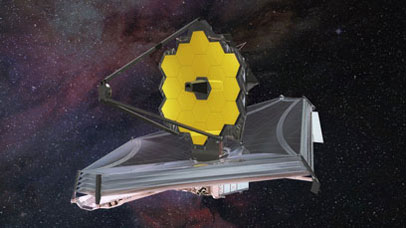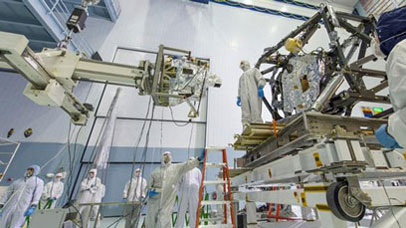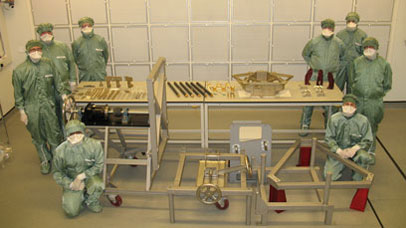University of Leicester scientists and engineers are involved in a major new space telescope, the most advanced observatory every built, scheduled for launch later this year from ESA’s spaceport in Kourou, French Guiana.

The James Webb Space Telescope (JWST) or simply “Webb”, is seen as a successor to the Hubble Space Telescope, but operates primarily at near- and mid-infrared wavelengths to enable the detailed exploration of the high-redshift and obscured universe, with likely targets ranging from nearby stars, extra-solar planets and our own solar-system, to the most distant and earliest galaxies and stars. Webb is a joint project of NASA, the European Space Agency and the Canadian Space Agency.
At 6.5-m diameter, its segmented primary mirror will be over twice the diameter of the Hubble mirror, making it more than 400 times more sensitive than current ground-based or space infrared telescopes. Webb will span the long-wavelength visible and the infrared spectrum from 0.6 to 28 µm with a set of four science instruments, and will spend five to ten years in operation, orbiting around the L2 Lagrange point (1.5 million kilometres from Earth). It features a very large sunshield (22 x 10 m) to cool the telescope and permit it to view objects in the infrared.
There will be four science instruments on the Webb Integrated Science Instrument Module (ISIM):
- Near Infrared/Visible Camera (NIRCAM),
- Near Infrared Spectrograph (NIRSPEC),
- Mid-Infrared Instrument (MIRI),
- Fine Guidance Sensor/Near InfraRed Imager and Slitless Spectrograph (FGS/NIRISS).
The key scientific goals of Webb span the whole range of scientific interests of University of Leicester scientists, including “First Light and Reionization” in the early universe, “Assembly of Galaxies,” “The Birth of Stars and Protoplanetary Systems,” and “Planetary Systems and the Origins of Life.”
Leicester and Webb
University of Leicester scientists and engineers have been involved in the Webb project for more than twenty years. The University of Leicester Space Research Centre, in the School of Physics and Astronomy, has provided the Mechanical Engineering Lead for the Mid-Infrared Instrument (MIRI), has been responsible for design and provision of the MIRI Primary Structure (in collaboration with the Danish National Space Centre), and provides support for MIRI test and calibration activities.

MIRI has been developed jointly by Europe and the USA. The European Consortium for MIRI is led by STFC’s Astronomy Technology Centre, Edinburgh, managed by Airbus Defence and Space UK, and the AIV (Assembly, Integration and Verification) and Thermal Leads are provided by STFC’s RAL Space near Didcot, Oxfordshire. The UK contribution to MIRI is funded by the UK Space Agency.
MIRI consists of two separate channels which provide high-resolution images and medium-resolution spectra in the 5-28 μm band. The imager subsystem consists of a filter wheel, folding optics and a solid-state infrared detector. It is capable of providing diffraction-limited images with a pixel size of 0.1 arcsecond. The three detectors, which have been provided by the US, are each a 1024 x 1024 Si:As detector array; the imager has one detector and the spectrometer has two. The filter wheel includes a grism for low-resolution spectroscopy (R ~ 100 for 5-10 µm) and various phase masks for coronography. The operational temperature of MIRI is ~7 K. MIRI has overall dimensions ~1 m3 and mass ~100 kg. The spectrometer sub-system consists of an integral-field spectrometer that can provide spatially-resolved spectroscopy, with a spectral resolution of R ~ 3000 at 5-30 μm and a field-of-view varying from 4″ to 8″ depending on the wavelength. It incorporates two infrared detectors, identical to the one used in the imager channel.

The Flight Model of MIRI was delivered to NASA in May 2012, and has been fitted into the JWST Integrated Science Instrument Module (ISIM) which houses all the science instruments.
As well as heavy involvement by University of Leicester engineers and scientists in the MIRI instrument development, University scientists are strongly participating in the Webb science programme, in a wide range of projects covering many aspects of astrophysics and planetary science, described in more detail in our webpages.

 Subscribe to Physics & Astronomy's posts
Subscribe to Physics & Astronomy's posts
Recent Comments